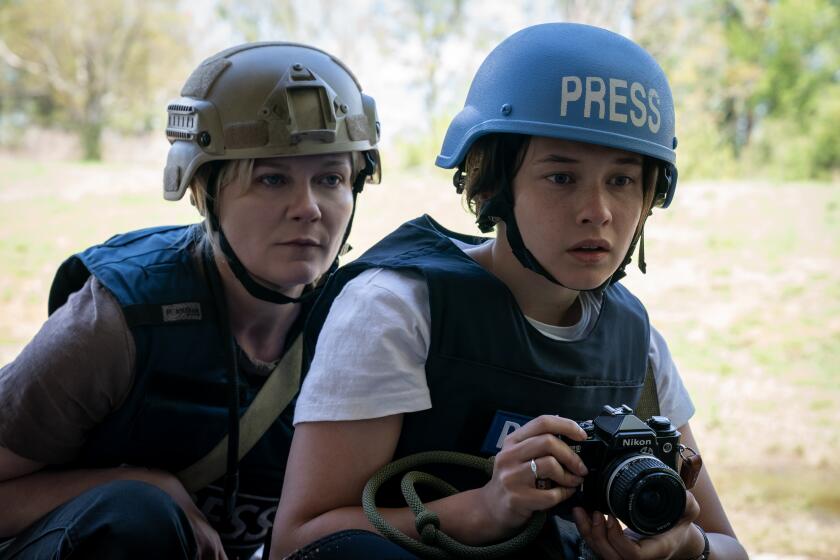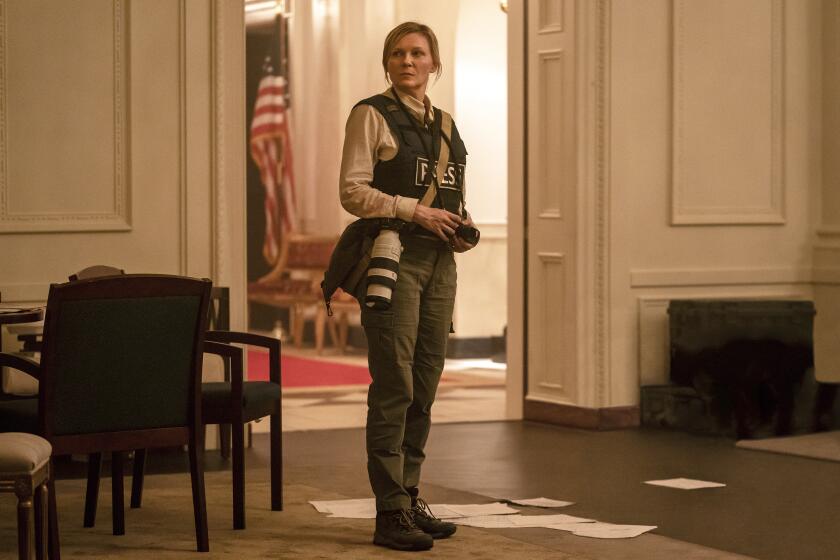Review: ‘Roma’ lives up to lofty expectations with a beautiful, deliberate and ultimately moving portrait of domestic life
Alfonso Cuarón’s “Roma” has been the talk of the international film world since it won the Golden Lion at the Venice Film Festival in September, and at first — but only at first — it’s hard to see exactly why.
For what all the fuss has done, as pre-release fusses inevitably do, is create expectations and misapprehensions. Not about the quality of the movie, which is impeccable, but about its very nature.
Unlike other highly publicized projects like the gangbusters “A Star Is Born” or “Black Panther,” “Roma” is an extremely quiet, even meditative picture.
It’s a quite personal project played at the softer pitch of reality, rather than the higher frequency of drama by writer-director-producer Cuarón, whose childhood experiences are the bedrock of this family story and who also served as the film’s editor and cinematographer.
But because intense, life-threatening events arrive unbidden in these lives, and because the largely nonprofessional cast responds beautifully and without obvious effort, by the time “Roma” earns its R rating, we feel we haven’t merely witnessed a life, we’ve been fully immersed in one, and that makes all the difference emotionally.
Cuarón is one of contemporary cinema’s most accomplished and versatile directors, with movies like the space opera “Gravity,” the dystopian “Children of Men” and even “Harry Potter and the Prisoner of Azkaban” to his credit.
Although Cuarón’s resume is determinedly eclectic, “Roma” is something new even for him. Echoing in some ways the classics of Italian neo-realism, especially in its use of black and white, it is an epic of everydayness, as polished a personal film as you are likely to see.
Set in 1970 and 1971 and named after Colonia Roma, the Mexico City neighborhood Cuarón grew up in, “Roma” is as much a way-back machine as a movie, a boggling exact replica in objects as well as people from the director’s memory of this very specific time and place.
To help set the scene, wizardly production designer Eugenio Caballero (“Pan’s Labyrinth”) found a Mexico City house scheduled for demolition and reconfigured it to nearly duplicate Cuarón’s boyhood home. The director’s sympathetic family members saw to it that an estimated 70% of the furniture on-screen are the items he saw as a child.
Cuarón also insisted that the cast members remind him of the real people who inspired the characters. After a literal village-to-village search for the picture’s protagonist, he found schoolteacher Yalitza Aparicio, luminous as Cleo, the family’s live-in maid/nanny modeled after the woman Cuarón considers a second mother.
The director not only wrote part of Cleo’s dialogue in Mixtec, one of his country’s indigenous languages, but he also hired Aparicio’s best friend to play her best friend in the picture so that they could be comfortable speaking Mixtec together.
That verisimilitude is, not surprisingly for a filmmaker of Cuarón’s abilities, no more than a means to an end. “Roma” is not a story of childhood remembered so much as childhood reflected upon from the wider, more sophisticated vantage point of adulthood — the better to determine what actually happened and what it might mean.
At its core, “Roma” is the story not of the young Cuarón, his siblings or his parents, but of Cleo, the emotional and physical constant in his life. Though set decades ago, it deals with very contemporary themes like the power of sisterhood and the nature of family and how both are necessary as bulwarks against the fragility and unfairness of life.
First thing you notice about “Roma,” aside from its intricate Dolby Atmos sound design, is the nature of its glowing black-and-white wide-screen cinematography.
Shot with a large-format digital camera and featuring frequent and hypnotic camera pans, “Roma” is not photographed by Cuarón’s regular cinematographer, the brilliant three-time Oscar winner Emmanuel Lubezki. Due to a scheduling conflict, the job fell to Cuarón himself, with impressive results.
“Roma” begins by following Cleo through her exhausting days, processing an enormous amount of laundry and housework and sticking like a second skin to the four children in her charge, putting them to bed, waking them up and doing everything in between.
RELATED: Alfonso Cuarón delves into his childhood for ‘Roma’ and already talk turns to Oscars »
Though the children’s mother, Sofia (Marina de Tavira), is involved, their doctor father is rarely there. He’s idolized when he does come home, carefully maneuvering his Ford Galaxy into a parking area that’s just a hair too small.
The dramatic engine of “Roma” is the parallel crises Cleo and Sofia go through, and how both the women and the family rise to meet the challenges.
First the return of the family’s father from a conference in Canada keeps getting postponed and postponed, with Sofia increasingly frantic, until the inevitable happens.
At roughly the same time, Cleo, who has been set up by her best friend with a young man from the military, endures unexpected consequences to that liaison.
Even though barriers of class remain between employer and employee, they realize that they have to reconfigure the family to survive not only the everyday but also unexpected tragedy.
One of “Roma’s” gifts is its ability to subtly interweave the political state of the nation with this personal story, culminating in a visually extraordinary re-creation of a notorious moment in modern Mexican history, the 1971 Corpus Christi massacre of university students.
Though it takes the risk of appearing too quiet too long, “Roma” and its melding of the personal with a glimpse of a society veering toward collapse is incontestably persuasive, a film whose like we will probably not see again.
-------------
‘Roma’
Rating: R, for graphic nudity, some disturbing images and language
Running time: 2 hours, 15 minutes
Playing: Opens Nov. 21 at Landmark, West Los Angeles (also streaming on Netflix beginning Dec. 14)

Nancy Garcia, Marina de Tavira and Yalitza Aparicio discuss working with Alfonso Cuarón on Netflix’s “Roma,” which won the top prize at the 2018 Venice Film Festival and is generating major awards season buzz.
More to Read
Only good movies
Get the Indie Focus newsletter, Mark Olsen's weekly guide to the world of cinema.
You may occasionally receive promotional content from the Los Angeles Times.







